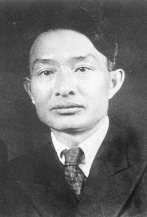Chen Changhao
| Chen Changhao | |
|---|---|
| 陈昌浩 | |
 Chen in Moscow (1950) | |
| Vice Director of the Compilation and Translation Bureau | |
|
In office 1953–1966 | |
| Personal details | |
| Born |
18 September 1906 Hanyang, Wuhan |
| Died |
30 July 1967 (aged 60) Beijing |
| Alma mater | Wuhan University, Moscow Sun Yat-sen University, Central China Normal University |
| Military service | |
| Nickname(s) | Cangmu |
| Allegiance |
|
| Commands | Red Fourth Army, West Army |
| Battles/wars | Encirclement Campaigns, Long March |
Chen Changhao (simplified Chinese: 陈昌浩; traditional Chinese: 陳昌浩; pinyin: Chén Chānghào; 18 September 1906 - 30 July 1967) was a member of the 28 Bolsheviks [1][2][3][4][5] and an important military figure of Zhang Guotao's 4th Red Army[6] from Hanyang, Wuhan. Chen had also been known as Cangmu.[7]
Biography
Chen had a childhood education that engraved his solid foundation in Sinology. In 1926, he was able to enroll into the Central China Normal University and in 1927 transferred to the Wuhan University. In the same year, he joined the Communist Youth League of China and following the White Terror in 1927, he enrolled himself to the Moscow Sun Yat-sen University in December. During his stay in Moscow, he became close associates with Wang Ming, Bo Gu and others would later form the 28 Bolsheviks.
Together with Shen Zemin and Shen Demin, he returned to China on 14 November 1930,[8][9] disclosing Comintern's October letter to Wang Ming.[8][10] By the end of 1930, Chen and Wang among others joined the Chinese Communist Party.[8][11] In the 1931 Fourth Plenary Session of the Chinese Communist Party, he was an ardent supporter of Wang Ming.[6][8][12][13] In November, he was appointed as the Political Commissar of The Red Fourth Army. Chen took part in a purge of the Red Fourth Army where more than 2,500 officers and men were executed for "counter-revolutionary" activities.[6][14]
On 12 October 1932, Chen and Zhang's Red Fourth Army was forced to leave the Anhui and Hunan Soviets due to a series of military defeats. Consequently, they set up the Shaanxi/Sichuan Soviet. Chen was elected to be an alternate member of the Central Committee in January 1934. Chen supported Wang Ming and Bo Gu in purging key founders of the Red Forth Army, such as Xu Jishen, Zhou Weijiong and others.[6][13][14]
In 1935, Chen was tasked to lead the Red Fourth Army on the Long March, and was to rendezvous in July at Xiaojin County, Sichuan. At the rendezvous with Mao Zedong Red First Army, the Fourth Army had far superior personnel numbers in the scale of eight to one. He entered the Politburo for a short period of time in August, but under the orders of Zhang Guotao to divert away from the route of the march, he led the Red Fourth Army and the Red Thirteenth Army Southwards.
Due to setbacks in the Xikang region, Chen and Zhang went into conflict with each other. In July 1936, Chen urged Zhang to pursue a northern route, influenced by Zhu De, Liu Bocheng and Xu Xiangqian, and by October Chen's force rendezvoused with the main CCP force in Huining, Gansu.[6][14]
After the failure to implement the "Ningxia Plan", Chen was appointed as Chairman of the Military Committee of the West Army,[15] to lead an attempt with Xu Xiangqian to open a passage to the USSR. However, after a 4-month battle against the Ma Clique in the Hexi Corridor and facing lack of reinforcements, the West Army was crushed. Chen was able to escape under the cover of wounded of the defeated West Army, and returned safely to Yan'an on 16 March 1937.[6][14][15][16] Due to the start of the Second United Front, he returned to the Shaan-Gan-Ning Border Region in mid August 1937.[6][14][15][16]
He became an lecturer at the Central Party School of the Communist Party of China and Counter-Japanese Military and Political University following his return to the Shaan-Gan-Ning Border Region. He made a successful request to be sent to USSR for "medical treatment" in August 1939. He was involved in the Battle of Moscow against Hitler's forces in 1941 and contributed to the city's rebuilding. From 1943 to 1952, Chen translated and edited works such as The Collected Works of Lenin and The Russo-Chinese Dictionary which became the de facto textbook for all Chinese students who were studying the Russian language.
In 1952 Chen returned to mainland China and was appointed deputy dean of the Central Institute of Marxism-Leninism. In 1953 he became the vice director of the Compilation and Translation Bureau. Following persecution during the Cultural Revolution, he committed suicide through poison in July 1967. His status was only politically rehabilitated on 21 August 1980.
Family
- First wife: Liu Xiuzhen and had two sons Chen Zuze, Chen Zutao
- Second wife: Zhang Qinqiu, Red Army commander, also committed suicide in 1968
- Third wife: Grania (Russian, divorced in 1960) with one son Chen Zumo
- Fourth wife: Meng Li (married in July 1965)
References
- ↑ 盛岳(盛忠亮):《莫斯科中山大学和中国革命》,东方出版社2004年版。
- ↑ 余笃三:《在“国际列宁学校培训班学生审查委员会1930年4月5日对余笃三清洗会议”上的回答和反驳》,余笃三档案,原苏中央档案馆,1930年。
- ↑ 孙耀文:《风雨五载:莫斯科中山大学始末》,中央编译出版社1996年版。
- ↑ 曹仲彬、戴茂林:《莫斯科中山大学与王明》,中共党史出版社1988年版。
- ↑ 江泽民(克明)《回忆在莫斯科中山大学时期》,载《革命史资料》第17辑,Chinese Literature and History Press. 1987年版.
- 1 2 3 4 5 6 7 徐向前:《历史的回顾》,解放军出版社1987年版。
- ↑ 陳昌浩 Archived April 10, 2011, at the Wayback Machine.,中國經濟網
- 1 2 3 4 张秋实:《解密档案中的瞿秋白》,东方出版社2011年版。
- ↑ 张明:《在莫斯科共产主义劳动大学学习期间的一些情况》 ,载《党史资料丛刊》第1辑,上海人民出版社1980。
- ↑ 戴茂林、曹仲彬:《王明传》,中共党史出版社2008 年版。
- ↑ 中央局∶《关于陈昌浩等六个同志问题决议》,1930年12月1日。
- ↑ 张金保:《张金保回忆录》,湖南人民出版社1985年版。
- 1 2 徐向前:《历史的回顾》,解放军出版社1985年版,第313页。
- 1 2 3 4 5 徐向前:《历史的回顾》,解放军出版社1984年版。
- 1 2 3 郭建波:《碧血黄沙 白骨青山——关于红西路军问题的历史考察》2012年。
- 1 2 黎汝请:《碧血黄沙 西路军苦战记》,北岳文艺出版社1995年版.